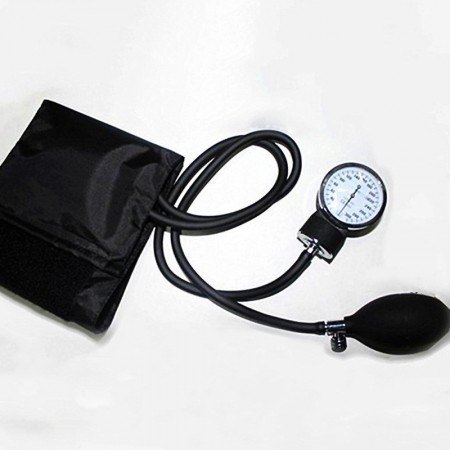Key Features:
Mechanism: An aneroid sphygmomanometer uses a mechanical system that includes a dial gauge calibrated to measure the pressure inside the cuff. It does not require electricity, making it suitable for use in various settings, including areas without reliable power sources.
Components:
- Cuff: Wraps around the upper arm and is inflated to temporarily stop blood flow in the artery.
- Bulb: Used to inflate the cuff manually.
- Valve: Allows controlled deflation of the cuff, enabling accurate measurement.
- Dial Gauge: Displays the measured blood pressure readings.
Operation: The user inflates the cuff using the bulb until the blood flow in the artery is stopped. As the valve is slowly opened to deflate the cuff, the user listens with a stethoscope placed over the brachial artery for the first Korotkoff sound (indicating systolic pressure) and the disappearance of sounds (indicating diastolic pressure).
Benefits:
Accuracy: When used correctly, manual sphygmomanometers provide highly accurate measurements, which is crucial for diagnosing hypertension and monitoring treatment.
No Electricity Required: Their non-electric nature makes them dependable in diverse environments, from hospitals to remote clinics without access to electrical outlets.
Adjustability: They can be used on patients of different sizes simply by choosing the appropriate cuff size, ensuring accurate readings across a wide range of patient populations.
Usage Tips:
Proper Cuff Placement: Ensure the cuff is properly positioned on the patient's upper arm, directly over the brachial artery. Incorrect placement can lead to inaccurate readings.
Calibration: Regular calibration is essential to maintain accuracy. Most manufacturers recommend annual calibration or after any accidental drops or damages.
Training: Proper training in auscultatory technique (listening for Korotkoff sounds) is necessary for accurate measurement. Improper technique can result in incorrect readings.
In summary, a special manual blood pressure meter (aneroid sphygmomanometer) is an indispensable tool for healthcare providers due to its precision, reliability, and ease of use in various conditions. Its ability to function without electricity and provide accurate blood pressure readings makes it a preferred choice for clinical settings. Correct usage, regular maintenance, and proper training are key to ensuring its effectiveness and longevity.




